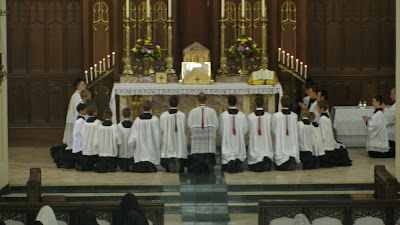1) To honor Our Lord, who is truly present in the Holy Eucharist
2) To instruct others on the faith, mystery, and devotion concerning the Holy Eucharist
3) To show our appreciation for the great gift of the Holy Eucharist
Around the early 1200s, Saint Juliana of Mont Cornillon received a vision concerning this feast at a young age. St. Juliana always had a strong devotion to the Blessed Sacrament. In her vision, she saw the Church under the appearance of the full moon. One large, dark spot was in the moon - symbolic of the absence of a solemnity to honor the Holy Eucharist. St. Juliana became an Augustinian nun in Liége, France, in 1206. Corpus Christi became a feast for the Diocese of Liege in 1246, and later in 1312 Corpus Christi became a mandatory feast in the Roman Catholic Church










2 comment(s):
What a beautifuk Church!
Therese
Matthew, please correct my spelling above.- Therese
Post a Comment